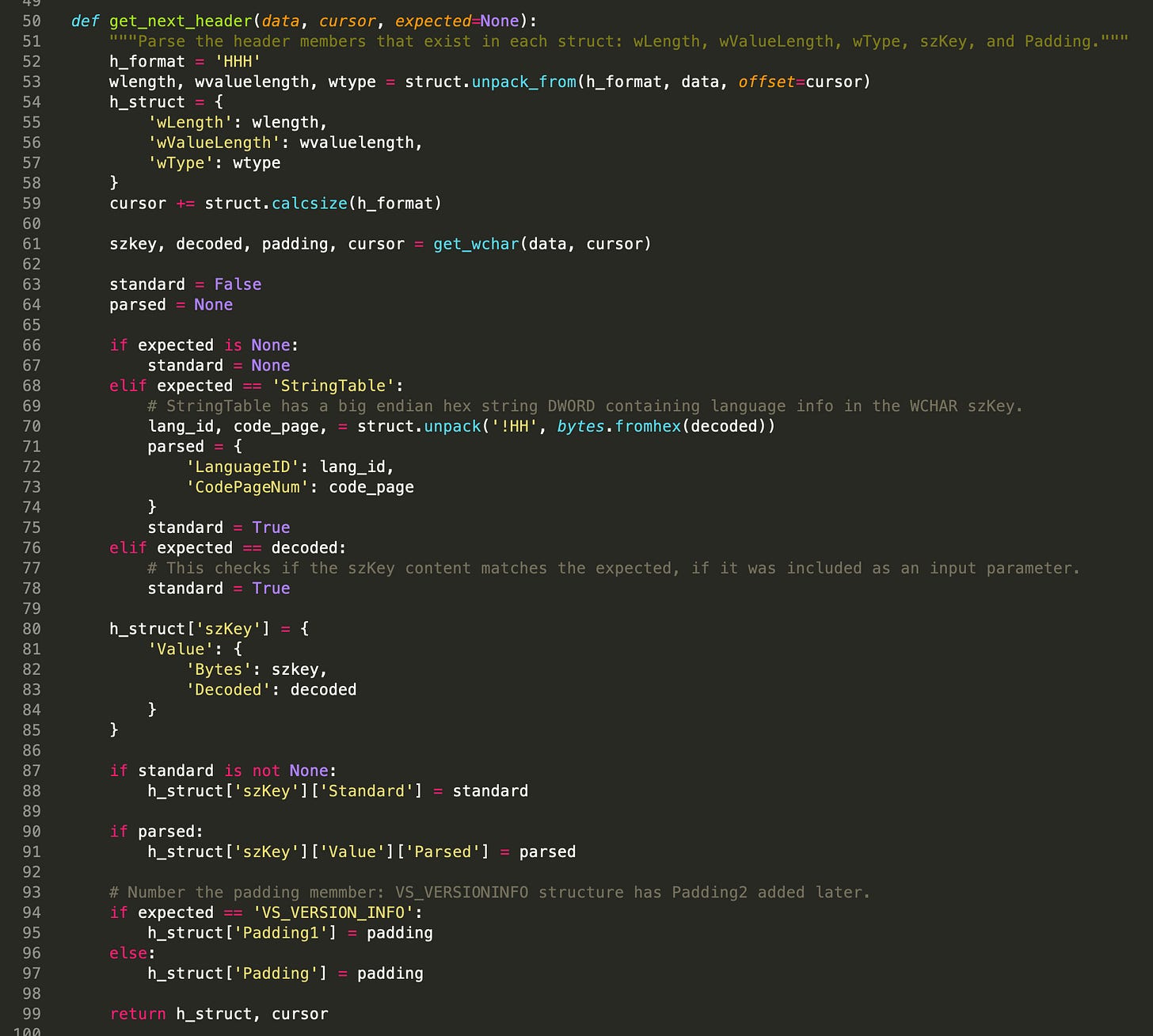Version Information Structure Parser
A Python Library
Each code screenshot has a link in the caption taking you to the relevant lines in the source code on Github.
Summary
The packer identified in a previous post employs a technique to hide version information metadata from standard parsers by changing the expected string in the szKey member of the StringFileInfo and VarFileInfo structures. The problem is that by being outside of standard parsing, the information in these structures cannot be easily used in malware analysis. What follows presents a new Python library, versioninfo, which performs a less strict parsing of these structures. It takes as its input the contents of an RT_VERSION resource and it emits either a Python dictionary or JSON. The raw bytes in certain fields are available directly in the Python dictionary, and to preserve the fidelity of the content in these same fields, they are Base64 encoded in the JSON output.
A Single Core
A careful reading of the documentation for each of the structures contained in this resource shows that there is a single header pattern in almost all of them. The header is made up of four members.
Structure length:
wLengthValue length:
wValueLengthData type:
wTypeText string:
szKey
This pattern is repeated in each of the different container structures.
VS_VERSIONINFOStringFileInfoStringTableStringVarFileInfoVar
In addition to these containers, there are three types of value structures. These are found in the Value member of certain of the container structures.
With these requirements in mind, I developed a single core parser that handles any of the container headers.
For malware analysis, I don’t want to drop anything. Therefore, the parser can be given input in the expected parameter so that it checks if the szKey is as expected or not, but this check does not stop the process. In fact, the result of the check is included in the output. A failed check indicates the adversary has modified the content to hide metadata from being collected. This is Obfuscated Files or Information in both the Malware Behavior Catalog (MBC) and ATT&CK Framework.
Observations
Determining Structure Type
The top level container structure, VS_VERSIONINFO, has two possible types of children: StringFileInfo and VarFileInfo. The documentation states that there can be zero or one of either.

VS_VERSIONINFO DocumentationThis presents a problem for structure identification without using the content of the szKey which can be modified by the adversary. The way to differentiate these structures is actually to examine the first child structure of the one in question. The children of StringFileInfo structures are StringTable structures. A StringTable structure does not have a Value member and its wValueLength is always zero. On the other hand, the children of a VarFileInfo structure are all Var structures. The Var structure has a Value member and it is an array of one or more entries of type DWORD. Therefore, the wValueLength member is always greater than or equal to four. A simple diagnostic of checking the wValueLength member of the immediate child of the structure in question yields the structure’s type.

*FileInfo Structure TypeA Square Peg In a Round Hole
The szKey member of the StringTable structure is different from all the others. It is a WCHAR and null terminated, but the content is not just a text string. It is actually a hexadecimal string containing two WORD values. The most significant WORD is a language identifier, and the least significant is a code page. On top of the documented formatting, it is also big endian.

StringTable DocumentationBecause of this oddity, the core parser has an extra step where additional parsing occurs. The results are included in the JSON output. I have made an assumption that this member is standard, but the content in these values may be stomped.

StringTable szKeyFuture Improvements
An area of improvement is in the parsing of the VS_FIXEDFILEINFO structure. The member dwFileFlags potentially contains a number of interesting flags such as VS_FF_DEBUG and VS_FF_PATCHED among many others. The former indicates that the PE was compiled with debugging enabled or contains debugging information. The latter indicates that the PE has been modified from the original file shipped with the same version number. Obviously, these may have no relationship to the actual content of the PE file when dealing with malware. However, these flags could be set in an identifying or unique combination. Similarly, the members dwFileOS, dwFileType, and dwFileSubtype each have a similarly rich set of potentially interesting flags. A more fine grained parsing of these flag fields is an area to improve this library.




